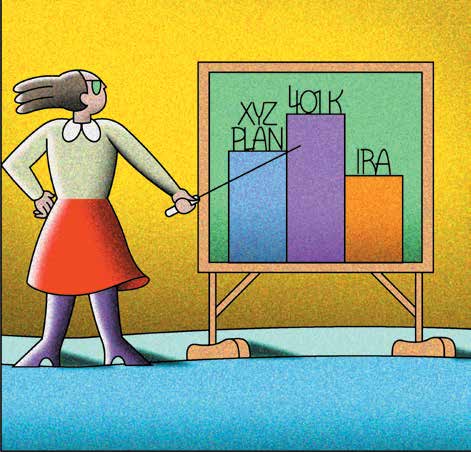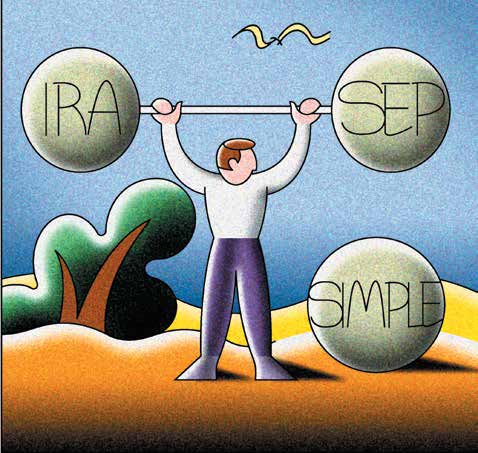Retirement Plans
upon retirement or a guaranteed monthly benefit. The
Does your employer provide a retirement plan? If so,
amount of payout is typically based on a set formula,
say retirement experts . . . grab it! Employer-based
such as the number of years you have worked for the
plans are the most effective way to save for your future. employer times a percentage of your highest earnings What’s more, you’ll gain certain tax benefits.
on the job. Usually the employer funds the plan —
Employer-based plans come in one of two varieties
commonly called a traditional pension plan — though
(some employers provide both): defined benefit and
in some plans workers also contribute. Most defined
defined contribution.
benefit plans are insured by the federal government.
How To Make The Most Of A Defined Contribution Plan
• Study your employee handbook and talk to your benefits administrator to see what plan is of fered and what its rules are. Read the summary plan description for spe cifics. Plans must follow federal law, but they can still vary widely in contribution limitations, in vest ment op tions, employer match es, and other features.
• Join as soon as you become eligible.
• Put in the maximum amount allowed.
• If you can’t afford the maximum, try to contribute enough to maximize any em ploy er match ing funds. This is free money!
• Study carefully the menu of investment choices. Some plans offer only a few choic es, oth ers may offer hun dreds. The more you know about the choices, in vest ing, and your in vest ment goals, the more likely you will choose wisely.
• Many companies match employee contributions with stock instead of cash. Financial ex perts often rec om mend that you don’t let your ac count get overloaded with com pany stock, par ticularly if the account makes up most of your retirement nest egg. Too much of a sin gle stock increases risk.
• Plan fees and expenses reduce the amount of retirement benefits you ul ti mate ly re ceive from plans where you direct the investments. It’s in your interest to learn as much as you can about your plan’s ad min is tra tive fees, investment fees, and service fees. Read the plan doc uments carefully. For more information on fees, call EBSA’s toll-free line at 1-866-444-3272 and re quest the booklet A Look at 401(k) Plan Fees.
Defined Contribution Plans. The popular 401(k)
plan is one type of defined contribution plan. Unlike a
defined benefit plan, this type of savings arrangement
does not guarantee a specified amount for retirement.
Instead, the amount you have available in the plan to
help fund your retirement will depend on how long you
18

EMPLOYER
EFITNESS PROGRAM
participate in the plan, how much is
invested, and how well the investments
do over the years. The fed eral gov-
ernment does not guarantee how much
you accumulate in your account, but it
does protect the account assets from
mis use by the employer.
In the past 20 years, defined
con tri bu tion plans have become more
common than traditional defined
benefit retirement plans. Employers
fund most types of defined contribution
plans, though the amount of their con-
tri bu tions is not necessarily guaranteed.
Workers with a retirement
plan are more like ly to be covered by
a de fined con tri bu tion plan, usually a
401(k) plan, rath er than the traditional
defined benefit plan. In many defined
contribution plans, you are of fered
a choice of investment op tions, and
The tax deduction also means that the decline
you must de cide where to invest your con tri bu tions.
in your take-home pay, because of your contribution,
This shifts much of the re spon si bil ity for re tire ment won’t be as large as you might think. For example,
planning to work ers. Thus, it is crit ical that you choose let’s assume you are thinking about putting $100 into to contribute to the plan once you be come eligible
a retirement plan each month and that the rate you
(usually after working full time for a min imum period) pay on income taxes is 15 percent. If you don’t put and, even if you are automatically enrolled in the plan, that $100 into a retirement plan, you’ll pay $15 in to contribute as much as possible. Invest wisely —
taxes on it. If you put in $100, you postpone the taxes.
review your plan in vest ment options and revisit your
Thus, your $100 retirement plan contribution would
choices at least once a year.
actually reduce your take-home pay by only $85. If
Tax Breaks. Even though you may be responsible for
you’re in the 25 percent tax bracket, the cost of the
fund ing a de fined contribution plan, you receive
$100 contribution is only $75. This is like buying your
important tax breaks. The money you invest in the
retirement at a discount.
plan and the earn ings on those contributions are
Vesting Rules. Any money you put into a retirement
deferred from income tax until you withdraw the
plan out of your pay, and earnings on those
money (hopefully not un til re tire ment). Why is that
contributions, always belong to you. However, contrary
important? Because postponing tax es on what you
to popular belief, employees don’t always have
earn allows your nest egg to grow faster. Remember
immediate access to the money their employer puts
the power of compounding? The larger the amount you into their pension fund or their defined contribution have to compound, the faster it grows. Even af ter the
plan. Under some plans, such as a traditional pension
withdrawals are taxed, you typically come out ahead.
plan or a 401(k), you have to work for a certain number
U.S. Department of Labor Employee Benefits Security Administration 19
SAVINGS FITNESS A GUIDE TO YOUR MONEY AND YOUR FINANCIAL FUTURE
of years — say, 3 — before you become “vested” and
Be aware of the vesting rules in your
can receive benefits. Some plans vest in stages. Other
employer’s plan.
defined contribution plans, such as the SEP and
Make sure you know when you’re vested.
the SIMPLE IRA, vest immediately. You have access
Changing jobs too quickly can mean losing part or all
to the employer’s contributions the day the money
of your retirement benefits or, at the very least, your
is deposited. No employer can require you to work
employer’s matching contributions.
longer than 7 years before you become vested in your
Retirement Plan Rights. The federal government
retirement benefit.
regulates and monitors company retirement plans.
The vast majority of employers does an excellent job
in complying with federal law. Unfortunately, a small
fraction doesn’t. For warning signs that your 401(k)
Retirement Planning For Employees In Small Companies
If you don’t have a plan available at work, encourage your employer to start one. Many small employers be lieve their work ers pre fer high er sal a ries or oth er ben e fits, and they be lieve the rules are too com plex and the costs too high.
Mention the following benefits:
• A retirement plan can attract and retain valued employees in a com petitive la bor mar ket, as well as mo ti vate workers.
• Establishing a retirement plan and encouraging employee par tic ipa tion can help em ploy ers fund their own retirement. Even after taking in to account the cost of es tab lish ing an em ploy ee plan, employers may still be bet ter off than funding retirement on their own.
• Some plans cost less and have fewer administrative hassles than em ployers may re al ize.
Alternatives to tra ditional defined benefit plans and the 401(k) include the SIMPLE IRA and the SEP.
For more information, contact EBSA at 1-866-444-3272 and request Choosing a Retirement
Solution for Your Small Business, SIMPLE IRA Plans for Small Businesses, SEP Retirement
Plans for Small Businesses, 401(k) Plans for Small Businesses, Automatic Enrollment
401(k) Plans for Small Businesses, Profit Sharing Plans for Small Businesses, or Payroll
Deduction IRAs for Small Businesses.
contributions are being misused and other information
on protecting your retirement benefits, visit EBSA’s
website at www.dol.gov/ebsa or call EBSA’s toll-free
number at 1-866-444-3272 and request the booklet
W hat You Should Know About Your Retirement Plan.
20

FINANCIAL FITNESS FOR
FTHE SELF-EMPLOYED
Types Of





